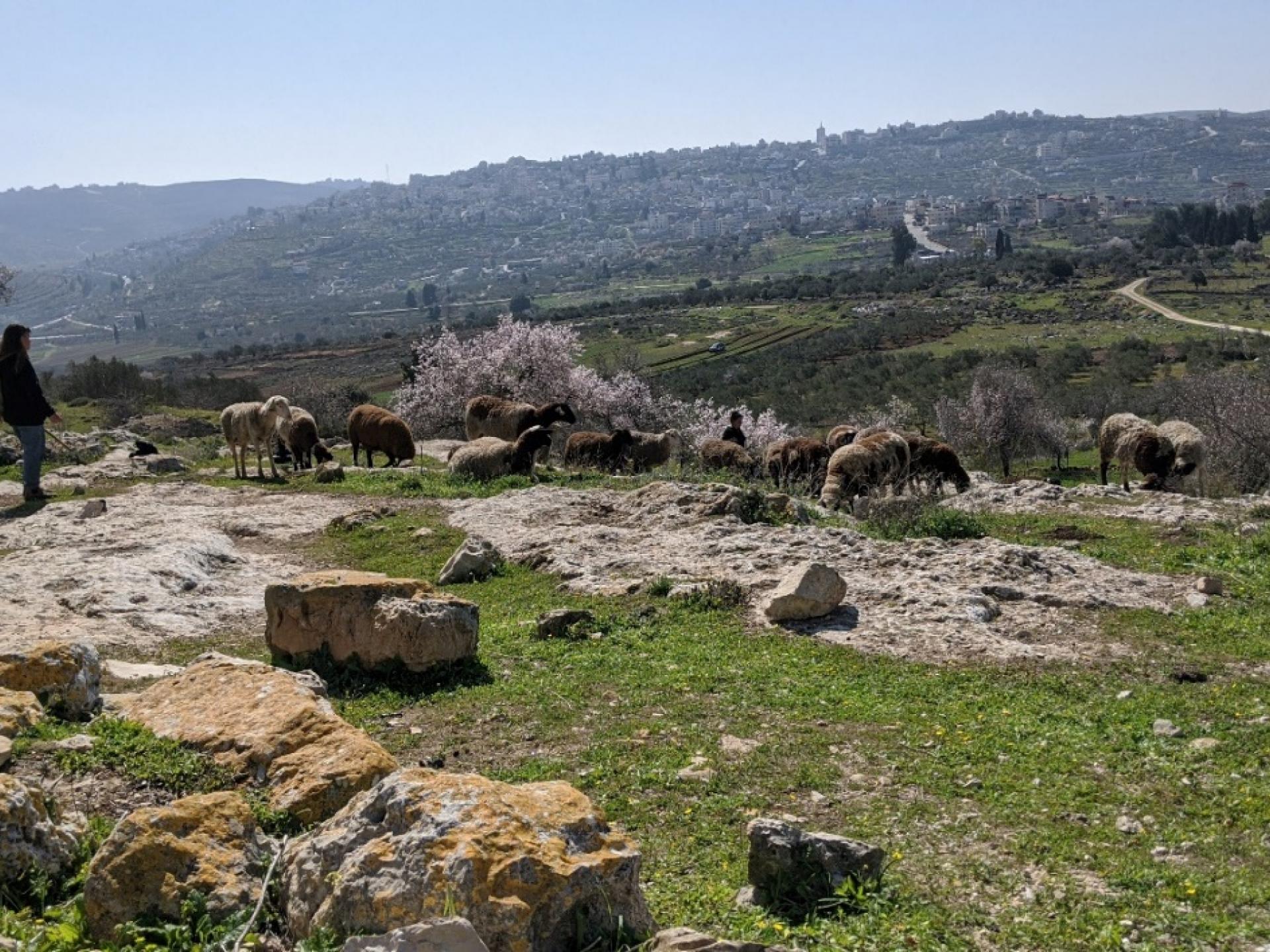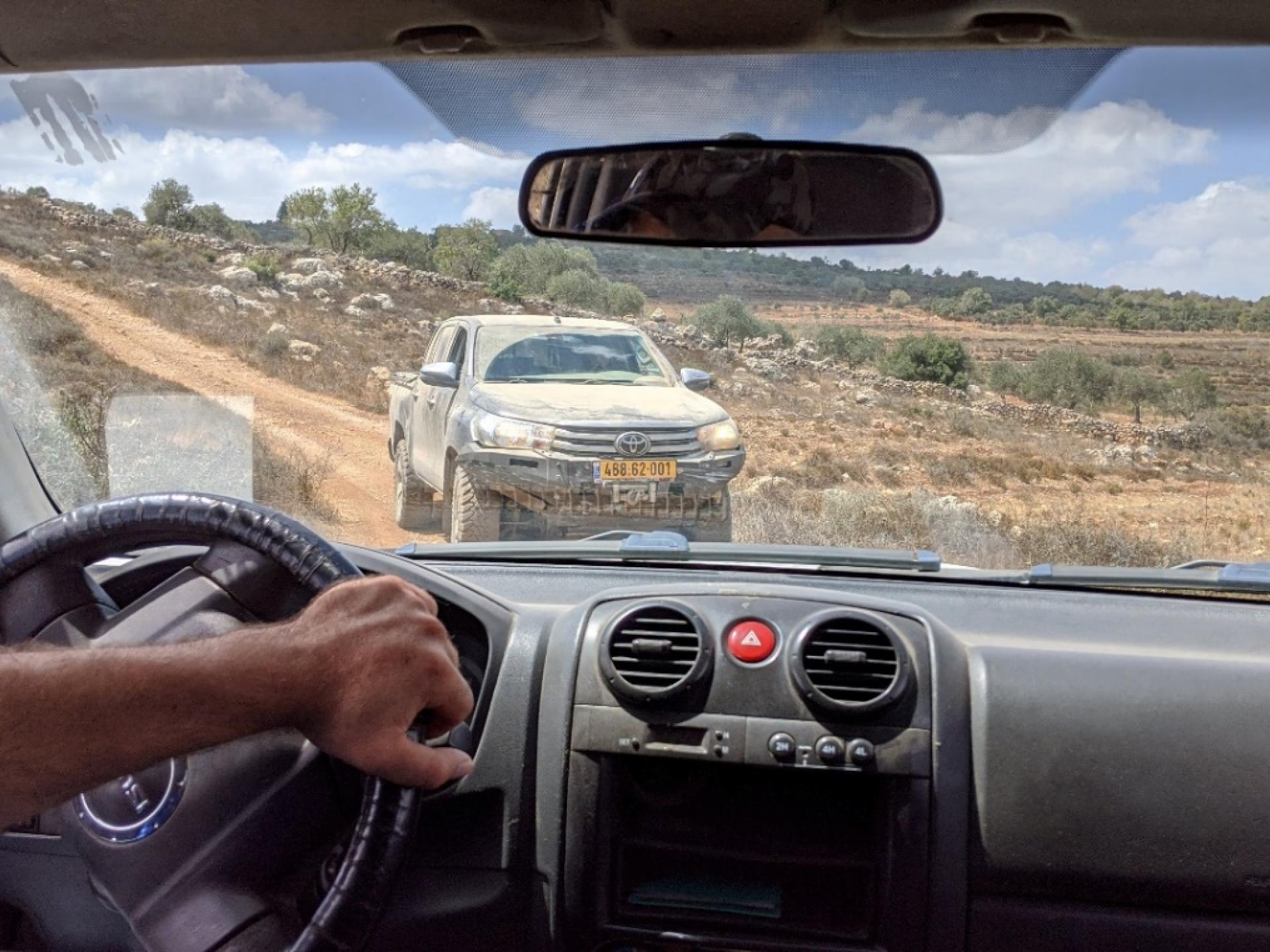Sinjil – The settler Michael Shemla’s flock grazing in the territory of the Maqam
What’s in the photo? A flock of sheep chewing grass in a primeval landscape, against the background of blossoming almond trees. The photo does not reveal the fact that the flock belongs to the violent colonist Michael Shemla of the “Nahal Shilo” outpost, not to the Palestinians of Sinjil, legal owners of the land.
The flock, the two shepherdesses and two dogs situated themselves this time around and inside the site sanctified by the Sinjil villagers, Maqam Abu Al ‘Uf. We climbed up there, four MahsomWatch members accompanied by our friend Ayed of Sinjil. The shepherdesses were amazed by the strange guests that came with an indigenous Palestinian, and alerted their boss, Michael Shemla by phone – he hurried to show up and began to question who and what we were. The encounter was very tense. One of the two dogs came back and crossed the distance with a stone in his mouth. Our calm was important to the Palestinians with us. This was obvious and also discussed afterward. During this encounter, a father with his three children joined us and skillfully organized a campfire with water for tea.
Shemla: “Where are you from?” “What brings you here?” “Are you friends of Ayed and Marwah?”
After I answered that we are from Tel Aviv and that Ayed and Marwah who joined us are our friends, and that “we investigate Palestinian tradition and religious sites”, he asked: “Are you familiar with Chapter 17 of the Book of Judges, regarding Micha?” I answered “Yes, I’ve read about him.”
“His inn was under this structure” he explained, so we could understand who has the original claim to this place.
Now, writing this report, I tried to understand which Micha was discussed in the said chapter and found a rather actual character: A thief called Michiyahu returned the money he stole from his mother, and to reward him she ordered gold from a jeweler, to create a figurine for her son’s private sanctuary. He then appoints one of his sons as a priest. This chapter as well as the succeeding one, states that “At that time, there was no king in Israel and every man did as he pleased.”
Back to our days: The meager farmland remaining for the Sinjil villagers is divided into numerous tiny beautiful plots – in which the occupation regime forbids them the digging water holes, laying water pipes or building a shed that would protect them from the heat or the rain.
We first came to Maqam Abu Al Uf exactly three years ago, on February 22, 2020. It stands at the heart of Sinjil’s farmland, on a hill overlooking the entire town climbing on the opposite hill. There we met Marwah (a unique name meaning ‘the one who returns’) – a retired sports teacher and farmer who works his land every day. He saw us from afar, heard our Hebrew and was certain that we were colonists. Still, he decided to come – “Why should I fear? These are our lands”, he said in fluent Hebrew. “Who was Abu Al Uf?” we asked him. “He was a good friend of the Prophet Mohammad”, came the answer. When he was a 12-13 years old boy, he told us, he used to come to the Maqam every Thursday: “We would light candles, pray, make our requests. People would come from Sinjil, Turmus Aya and Nablus. The main road between Nablus and Ramallah used to pass here. To this day I come up here, rest, and pray at the Maqam. Now colonists visit the site. They even steal ancient stones from the structures here.”
Since then we have been following the processes of taking over Sinjil lands and attempts to expropriate the Muslim Maqam, forcing it into the Jewish narrative and passing it over to the colonists who frequent it: At times with their sheep who defecate in the holy place, and at others for group visits and refreshments.
On September 7, 2022 we reached a 10-dunam area of Palestinian farmland which the colonists’ bulldozers flattened and denied Palestinian access. We joined the Sinjil municipal vehicle and held video interviews there. Exiting the area up a narrow track, Michael Shemla’s vehicle blocked our way and forced the municipality’s skilled driver to back up further and further down the slope. It was very frightening and left no room for mistaking the colonist’s intent.
The next day, Shemla attacked and wounded Palestinians who reached the land after receiving permission to do so from the Civil Administration at Beit El (we received video documentation of the attacks and testimonies of injured Palestinians).
at Beit El (we received video documentation of the attacks and testimonies of injured Palestinians).
General background: The Maqam and the Sinjil farmlands are surrounded by two large colonist outposts – “Giv’at Har’el” and “Giv’at Haro’e”, two of the ten outposts whose turning into full-fledged colonies was announced by the government. The two outposts originate from the huge colonies of Shilo, Eli and Ma’ale Levona. Michael Shemla’s farm, adjacent to an old Israeli army base, is the late addition that faithfully serves its mission – to injure, sow despair and dispossess the Palestinian landowners.
Concluding: Maqam Abu Al Uf was not included in our survey since at the time we did not know how active and determined the colonists attempts are to take it over. (It is not even included in the area of a colony, firing zone or nature reserve – the three categories detailed in our survey). Now, as the harsh picture becomes clear, I hope we can dedicate a special issue to it, including video interviews of September 7, 2022, and Palestinian videos of September 8, 2022, showing the cultural, historical and ritual background of Maqam Abu Al Uf.



